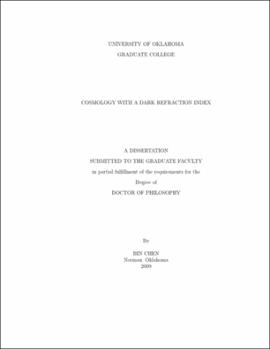| dc.contributor.advisor | Kantowski, Ronald | |
| dc.creator | Chen, Bin | |
| dc.date.accessioned | 2019-05-01T17:22:28Z | |
| dc.date.available | 2019-05-01T17:22:28Z | |
| dc.date.issued | 2009 | |
| dc.identifier | 99105976502042 | |
| dc.identifier.uri | https://hdl.handle.net/11244/319377 | |
| dc.description.abstract | In this dissertation we review Gordon's optical metric theory, generalize it, and apply it to modern cosmology. | |
| dc.description.abstract | In Chapter 1, we build the notation, define important quantities (luminosity distance, angular diameter distance, etc.), derive a few key equations (reciprocity relation, transport equations of optical scalars, etc.), and develop some basic techniques which will be useful later on. | |
| dc.description.abstract | In Chapter 2 we apply Gordon's optical metric theory to Friedman-Lemaitre-Robertson-Walker cosmologies. We associate a refraction index with the cosmic fluid and derive the refraction-corrected distance redshift relations. We then fit the Hubble curve of current supernova observations with a non-accelerating cosmological model. We also show that some observational effects caused by inhomogeneities, e.g., the Sachs-Wolfe effect, can be interpreted as being caused by an effective index of refraction, and hence this theory could extend to other speed of light communications such as gravitational radiation and neutrino fluxes. | |
| dc.description.abstract | In Chapter 3 we show that Gordon's optical metric on a curved spacetime can be generalized to include absorption by allowing the metric to become complex. We distinguish two different cases, i.e., strong and weak absorption, and demonstrate the use of the complex optical metric theory by giving three examples. We use one of these examples to compute corrected distance-redshift relations for Friedman-Lemaitre-Robertson-Walker models in which the cosmic fluid possesses a complex index of refraction that represents grey extinction. We then fit this corrected Hubble curve to the same supernovae data used in Chapter 2 by assuming pure absorption. | |
| dc.description.abstract | In Chapter 4 we equate the physical intensity reduction of a light wave caused by weak absorption with a geometrical reduction in intensity caused by a "transverse" conformal transformation of the spacetime metric in which the wave travels. We then modify Gordon's optical metric to include absorption via a totally different way than that of Chapter 3 in which we included absorption in Gordon's optical metric by allowing the metric to be complex. We derive the distance-redshift relation from the modified optical metric for Friedman-Lemaitre-Robertson-Walker spacetimes whose cosmic fluid has associated refraction and absorption coefficients. We then fit the current supernovae data with a cosmological model containing both refraction and absorption and provide an alternate explanation (other than dark energy) of the apparent acceleration of the universe expansion. | |
| dc.format.extent | 131 pages | |
| dc.format.medium | application.pdf | |
| dc.language | en_US | |
| dc.relation.requires | Adobe Acrobat Reader | |
| dc.subject | Cosmology | |
| dc.subject | Geometrical optics | |
| dc.subject | Maxwell equations | |
| dc.subject | Refractive index | |
| dc.title | Cosmology with a Dark Refraction Index | |
| dc.type | text | |
| dc.type | document | |
| dc.thesis.degree | Ph.D. | |
| ou.group | College of Arts and Sciences::Homer L. Dodge Department of Physics and Astronomy | |
